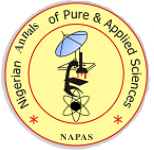The Diversity of Fish Species, Composition and Abundance from Bodna River in Kwali Area Council, Abuja.
DOI:
Keywords:
Diversity, composition, abundance, Bodna RiverAbstract
The Diversity of fish species, composition and abundance from Bodna River in Kwali Area Council, Abuja was studied between May 2018 to April 2019.The aim of the study was to determine the management and sustainable use of the fisheries resources of the Area council. About 1331 fish were collected from the artisanal fishermen during the study period and morphometric indices were determined using standard methods. The fish were identified and counted. Sex ratio 1:2:1 (Males to Females) was obtained indicating a male dominated population. Length –weight measurement indicated that the fish exhibited positive allometric growth pattern. The highest percentage abundant species in the site were Oreochromis niloticus with 34.8% Clarias garienpinus with 28.0% and Pellonula leonensis with 17.6% and the least occurring species were Nannocharax shariensis with 11.0% Mormyrus valenciensis with 7.7%. The seasonal variation of fish distribution was observed to be higher in the wet season with 66.2% than the dry season. Nutrient displayed greater impact on fish abundance in the wet season. The Simpson and Shannon Weiner’s diversity index values were (0.976) and (-1.456) in both richness and evenness respectively. The findings of the study could be helpful to the artisanal fishermen and the community for fisheries sustainability.



 Contact Us
Contact Us Editorial Team
Editorial Team Join As A Reviewer
Join As A Reviewer  Request For Print Copy
Request For Print Copy


 Cprint Publishers
Cprint Publishers